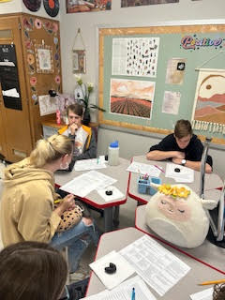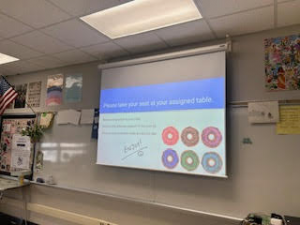For years, I have taught AP Literature & Composition on the project-based learning pathway. My peers in the AP world are always baffled when they find out that I follow a PBL model for my classes. However, upon closer examination, it might be much simpler than you think to identify PBL strategies already at work in your classroom. Even better, you might find some that are easily applicable to your own classrooms. These slight modifications can make a world of difference.
I begin planning a new unit by thinking about the most memorable experiences that I had while I was a student in a classroom. Certain books and units of study are recalled more easily than others, but this is not quite what I’m talking about. When were the times in which you felt very happy to be there? When did you feel like you were a part of a community?
My favorite memories from school all involved creating relationships with my peers and my teachers. One of the most important tenets of a PBL-centered classroom is collaboration. It is challenging to find ways for students to work together in class that is designed to challenge their individual reading, writing, comprehension, and analytical skills. However, these opportunities for collaboration often have a great impact on a student’s analytical skills.
“One of the most important tenets of a PBL-centered classroom is collaboration.”
Easy Classroom Collaboration Add-Ins
Some easy fixes to add more collaboration into your classroom are peer review and group papers. Additionally, students can work on a first draft of an AP prompted essay. Then, another student can grade using the official rubric. Then, another student can try to “elevate” their peer’s work to the next level. After this process, the small group can discuss each segment.

Collaborative Projects
A longer unit of study that includes one of my favorite collaborative projects is Short Fiction in the AP Classroom. This is the first project of the year, so my students dive right into working together, setting the tone for the rest of the year. For this project, students are assigned in partners or small groups, depending on the class size, to teach the rest of the class a lesson on an assigned short story with a focus on one of the skills taken directly from the AP Literature Course and Exam Description.
I like to preface this project by discussing the real-world skills these students are practicing. Teachers are not the only professionals who must guide instruction in the workplace. The students hone their presentation, oral communication, and abilities to check for understanding. Any manager and employee will eventually find themselves in this situation. See the attachments if you are interested in using this project in your own classroom!
Celebrations
Some of my other favorite moments from my own time as a student were when I felt my teachers were creating a sense of occasion in the classroom. This can be as simple as a real-world simulation or as complicated as an involved holiday party with many moving pieces inspired by the course content.

One way I do this is focusing units of study around holidays. For example, numerous creative and collaborative projects can enhance learning and engage students in older texts such as Frankenstein, Hamlet, and Macbeth around Halloween. Every year, my students and I arrange a “Monster Mash” Halloween party based on these works. Students are prompted to design gravestones for authors, create a “Party Playlist” in which they teach the rest of the class about their favorite songs that could perhaps allude to some of the themes in these older texts, and write elegies to the deceased characters in the books. This type of analysis helps students to move beyond plot summary and focus on larger messages.
Another fun and exciting time in my classroom is leading up to Valentine’s Day. The idea for this project actually came from feedback from the “Monster Mash” project. Students were eager for another chance to have a “special occasion” baked into the learning experience. As part of our curriculum, students create an “elementary school” style Valentine’s cardbox based on a book of their choice they read independently for the class. For this unit, we focus on symbolism. Students are instructed to represent at least 3 symbols from their work onto their boxes. Additionally, students focus on the AP Literature and Composition Course and Exam Description outlined Course Skills. For this portion, students created “teachable moments” Valentine’s cards they will explain and pass out to each of their classmates’ boxes. These cards should have a message of love on them as to why the AP test might “love” to feature them on the exam or an AP Reader might “love” to read an essay about them.
Students get extremely creative and have fun showing off how cleverly they are able to create these monuments to their chosen books. One student created a box that was made to look like a piano inspired by Jane Austen’s Persuasion. Another created a box of propaganda posters expressing their devotion to the dictator in George Orwell’s iconic 1984. Paper cut and folded to look like various pieces of tropical foliage were handed out as warnings of what happens when young men are stranded in the wild from William Golding’s Lord of the Flies. Please check out the link in resources if you are interested in adapting it for your classroom needs.
“Always remember, the most crucial element of PBL is to begin with the end in mind.”
AP Reading Day
One final project is the real-world simulation of “AP Reading Day” that can transform a student’s perspective on writing at any time of the year. For this project, you can print packets of the rubric and of students’ writing, set up conference style tables, and communal writing utensils. Set the scene with the slideshow attached in resources. I even like to provide donuts to add to the professional ambiance. This becomes a very structured activity by the end of the year, and it is a fun occasion that students look forward to after having spent a lot of time writing and completing assessments in the preceding days.
I hope that you find this crash course in Project Based Learning beneficial as you head into the second semester. Always remember, the most crucial element of PBL is to begin with the end in mind. Any one of these projects are great opportunities for students to collaborate and enhance their individual skills while doing so.
Resources
Please login or register to claim PGPs.
Alternatively, you may use the PGP Request Form if you prefer to not register an account.



